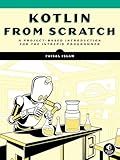Best Coding Guides to Buy in January 2026

Kotlin in Action, Second Edition



How to Build Android Applications with Kotlin: A hands-on guide to developing, testing, and publishing production-grade Android 16 apps



Head First Kotlin: A Brain-Friendly Guide



Java to Kotlin: A Refactoring Guidebook



Kotlin Design Patterns and Best Practices: Elevate your Kotlin skills with classical and modern design patterns, coroutines, and microservices



Kotlin from Scratch: A Project-Based Introduction for the Intrepid Programmer



Kotlin: An Illustrated Guide


To get the current working directory in Kotlin, you can use the following code:
import java.io.File
fun main() { val currentDirectory = File("").absolutePath println("Current Working Directory: $currentDirectory") }
In this code, we import the java.io.File class which provides methods for working with files and directories. Then, within the main() function, we get the current directory using File(""), passing an empty string as the argument. This creates a File object pointing to the current directory.
By calling absolutePath on the File object, we obtain the absolute path of the current directory. Finally, we print the current working directory using println.
When you run this code, it will display the current working directory in the console.
How to handle exceptions when retrieving the working directory in Kotlin?
In Kotlin, you can handle exceptions when retrieving the working directory by using the try-catch block. Kotlin provides the System.getProperty("user.dir") method to get the current working directory.
Here's an example of how you can handle exceptions when retrieving the working directory in Kotlin:
import java.lang.Exception
fun main() { try { val currentDir = System.getProperty("user.dir") println("Current working directory: $currentDir") } catch (e: Exception) { println("Error occurred while retrieving the working directory: ${e.message}") } }
In the above code, we wrap the code that retrieves the working directory inside the try block. If an exception occurs during this process, it will be caught by the catch block, and an error message will be printed.
Note: It's essential to handle exceptions appropriately to ensure your program's stability and to provide helpful error messages to the user.
What is the impact of running a Kotlin application with a non-existent working directory?
Running a Kotlin application with a non-existent working directory can have several impacts:
- Application Failure: The application might fail to execute properly or might not execute at all if it relies on files or resources that are expected to be present in the working directory. This can result in runtime errors, crashes, or unhandled exceptions.
- File I/O Issues: If the application performs file input/output operations and expects a specific working directory, it won't be able to access or create files in the non-existent directory. This can cause errors while reading or writing files, leading to data loss or incorrect behavior.
- Configuration Problems: If the application requires configuration files or resources located within the working directory, it won't be able to find them if the directory doesn't exist. This can lead to misconfiguration and incorrect application behavior.
- Dependency Resolution: Some Kotlin applications rely on build tools like Gradle or Maven to resolve dependencies. These tools typically use the working directory to search for build files and manage dependencies. If the working directory is non-existent, it can cause issues with dependency resolution and build failures.
- Integration Problems: If the application interacts with other systems or APIs and expects a specific working directory for communication or data exchange, it won't be able to perform these interactions. This can result in integration failures or incorrect behavior, especially if the application depends on relative paths or environment-specific configurations.
Overall, running a Kotlin application with a non-existent working directory can lead to various issues, including runtime errors, crashes, incorrect behavior, data loss, and integration failures. It is crucial to ensure that the working directory exists and contains the necessary files and resources for the application to function as expected.
What is the effect of changing the working directory inside a Kotlin function?
Changing the working directory inside a Kotlin function can have various effects. Here are a few possible scenarios:
- File operations: When performing file operations, such as reading or writing files, the working directory can affect the paths used. Changing the working directory could alter the relative paths used for file access. Therefore, if a function relies on relative paths, changing the working directory may lead to incorrect file operations or unexpected behavior.
- Resource loading: If the function loads resources from the file system or classpath, a change in the working directory can affect the ability to locate and load those resources. This is especially relevant when using relative paths or relative resource references.
- External process execution: If the function runs external processes using tools like ProcessBuilder, the working directory can impact where the external process runs and accesses files. Changing the working directory may lead to incorrect process execution or issues with file accessibility.
- Library dependencies: Some libraries or frameworks rely on the working directory for locating files or resources. Changing the working directory might interfere with those expectations and cause problems with library functionality.
It's important to note that changing the working directory should typically be done with caution and when absolutely necessary. It is generally recommended to use absolute paths or explicitly handle relative paths to avoid potential issues related to working directory changes.
How to resolve a relative path against the current working directory in Kotlin?
In Kotlin, you can resolve a relative path against the current working directory using the java.nio.file.Paths class. Here's an example:
import java.nio.file.Paths
fun main() { val relativePath = "subdirectory/file.txt" val currentDir = Paths.get("").toAbsolutePath().toString() val resolvedPath = Paths.get(currentDir, relativePath).toString()
println(resolvedPath)
}
In this example, the Paths.get("") method returns a Path object representing the current working directory. The toAbsolutePath() method converts the relative path to an absolute path, and the toString() method converts the Path object to a string.
By providing the current working directory and the relative path to the Paths.get() method, a resolved absolute path is obtained. In this case, it is the absolute path of the file "subdirectory/file.txt" relative to the current working directory.
Finally, the resolved path is printed, which would be something like "/path/to/current/directory/subdirectory/file.txt" depending on your system.
How to retrieve the parent directory of the current working directory in Kotlin?
In Kotlin, you can retrieve the parent directory of the current working directory using the File class. You can use the File class to represent directories and files, and then access their parent directories.
Here is an example of how you can retrieve the parent directory of the current working directory:
import java.io.File
fun main() { // Get the current working directory val currentDirectory = File(System.getProperty("user.dir"))
// Get the parent directory
val parentDirectory = currentDirectory.parentFile
// Print the parent directory path
println(parentDirectory.absolutePath)
}
In this example, we first get the current working directory using the System.getProperty("user.dir") method. Then, we use the parentFile property of the File class to retrieve the parent directory. Finally, we print the absolute path of the parent directory.
